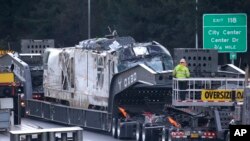Experts say it's possible the engineer on an Amtrak train that hurtled into a curve south of Seattle this week at more than twice the speed limit was distracted for a time before the train plunged off an overpass and onto a busy interstate.
Three men were killed Monday as a result of the derailment, which occured after the train barreled into a 30-mph zone at 80 mph near DuPont.
Authorities on Wednesday removed a train locomotive from the crash site and cleaned up debris before reopening two southbound lanes of Interstate 5 — the Pacific Northwest's main north-south arterial — that had been closed since the accident.
First run on route
The train, with 85 passengers and crew members aboard, was making the inaugural run along a fast, new, 15-mile bypass. A conductor in training who was familiarizing himself with the route was in the locomotive with the engineer at the time.
A federal official who spoke on condition of anonymity said authorities wanted to know whether the engineer lost "situational awareness" — meaning he didn't realize where he was.
Rail-safety experts say that while it is fairly common to have two people in a cab, investigators will look into whether that may have distracted the engineer.
"What interactions were the conductor and the engineer having, and did that distract the engineer from his focus on where they were on the route?" said Keith Millhouse, a rail-safety consultant and former board chairman of Metrolink, Southern California's commuter rail system.
Discussions to blame?
Millhouse said the two could have been having discussions that caused the engineer to not realize where he was on the route.
"My guess is there were probably distractions not only immediately prior to the accident but in the minutes leading up to the accident," he said.
Investigators have not yet interviewed the train engineer and other crew members, all of whom were hospitalized, a National Transportation Safety Board spokesman said. Experts said investigators would want to talk to them as soon as possible while the event was still fresh in their memory.
NTSB board member Bella Dinh-Zarr said distraction in the cab would be a focus of the accident probe, and that investigators would be looking at cellphone records of all employees.
Dinh-Zarr also said the engineer did not manually activate the emergency brake; it went off automatically when the train derailed.
"This is a situation where the engineer should have been starting the braking application probably a minute before they reached that curve," said Allan Zarembski, a civil engineering professor who directs the rail engineering and safety program at the University of Delaware.
"It suggests strongly that the engineer was distracted for a fairly extended" period, he said.
In some previous wrecks, train operators were found to have been seriously fatigued or distracted by a cellphone or something else.
Multiple crew members
Railroad unions have repeatedly urged that a second crew member be added in cabs. But former NTSB chief railroad crash investigator Ed Dobranetski has said that putting multiple crew members in a locomotive was "more of a distraction" than a safeguard.
The former investigator pointed to a deadly 1996 collision near Washington, D.C., between an Amtrak train and a Maryland commuter train that had three crew members in the cab. The engineer of the commuter train was thought to have been distracted by a conversation with the other crew members. The train ran through a speed restriction, reaching 66 mph in a 30-mph zone, and blew through a stop signal before slamming head on into the Amtrak train. Eleven people were killed.
"Conversation creates a potential for distraction and interference with the engineer's retention of information — in this case, the signal information," the NTSB wrote in its report on the 1996 crash.
Washington Governor Jay Inslee said Wednesday that Amtrak President Richard Anderson told him the rail company would pay the costs of the derailment as well as the medical and other expenses of the victims. He also said Anderson would try to ensure a type of technology that can automatically slow or stop a speeding train — known as positive train control — was in place statewide before a December 31, 2018, federal deadline.
That technology was not in use on the stretch of track involved in Monday's crash.
Regulators have been pressing railroads for years to install such technology, and some have done so, but the deadline has been extended repeatedly at the industry's request.










